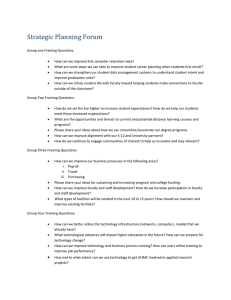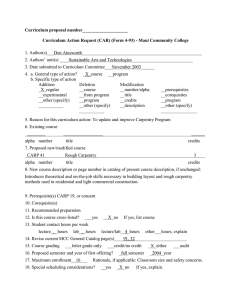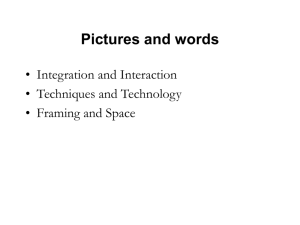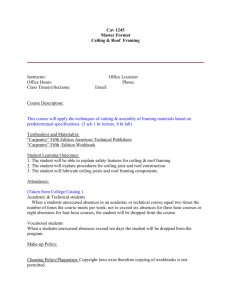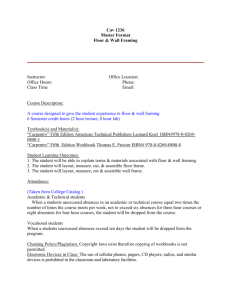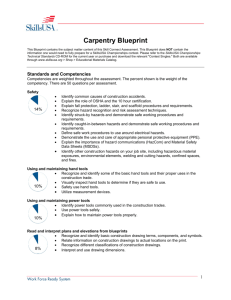Maui Community College Course Outline 1. Alpha and Number:
advertisement
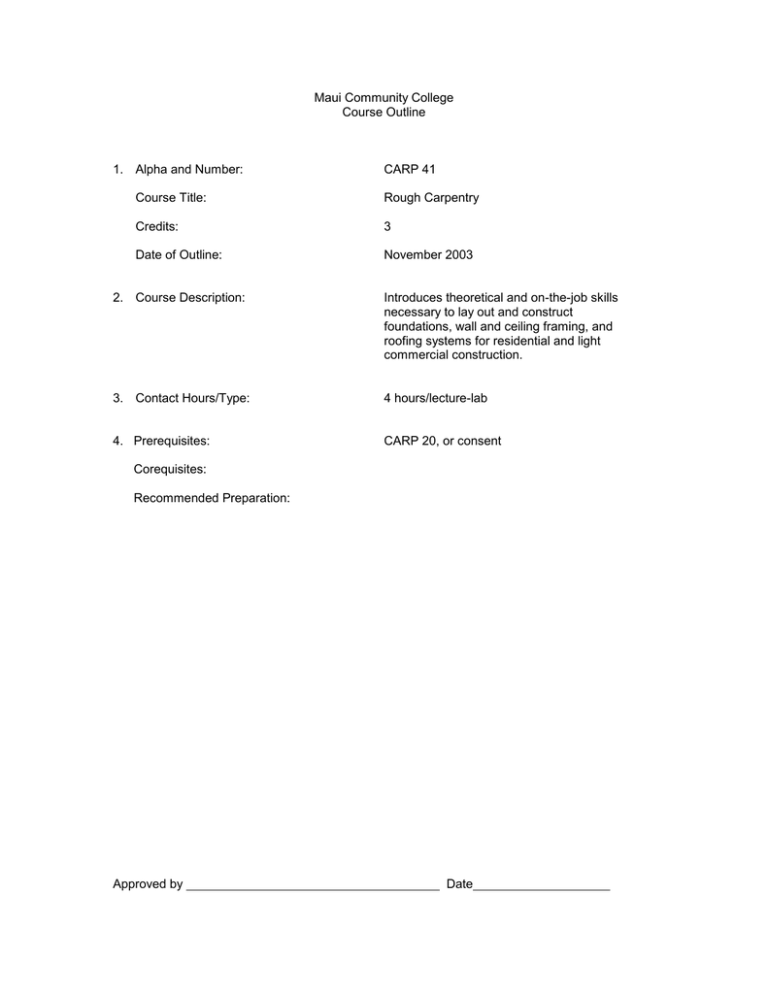
Maui Community College Course Outline 1. Alpha and Number: CARP 41 Course Title: Rough Carpentry Credits: 3 Date of Outline: November 2003 2. Course Description: Introduces theoretical and on-the-job skills necessary to lay out and construct foundations, wall and ceiling framing, and roofing systems for residential and light commercial construction. 3. Contact Hours/Type: 4 hours/lecture-lab 4. Prerequisites: CARP 20, or consent Corequisites: Recommended Preparation: Approved by Date 2 5. General Course Objectives This course is designed to teach technical and practical skills necessary in the construction of residential and light commercial buildings using industry safety and design standards, and in compliance with local building codes and ordinances. 6. Specific Course Objectives, Competencies, and Student Learning Outcomes For assessment purposes, these are linked to #7. Recommended Course Content. On successful completion of this course, students will be able to: a. accurately set up and use the builders level, transit level, and laser level; b. use an optical level to determine elevations; c. lay out building lines by using the Pythagorean theorem and check the layout for accuracy; d. build batter boards and accurately establish building location with string lines; e. describe and identify framing members of platform, balloon, and post-and-beam systems; f. describe several energy and material conservation framing methods; g. build and install girders, erect columns, and lay out sills; h. lay out and install floor joists including openings, bridging, and subflooring; i. describe methods used to prevent destruction by wood pests; j. identify and describe the function of each part of the wall frame; k. lay out the wall framing for partition intersections, openings, and O.C. studs; l. describe at least two methods of framing a corner and framing a partition intersection; m. assemble and construct wall sections, including all blocking and backing; n. apply wall sheathing; o. lay out, cut, and install ceiling joists and/or roof trusses; p. identify and describe safety concerns for scaffolds; q. erect and dismantle metal scaffolding in accordance with recommended safe practices; r. describe the safe use of ladders, ladder jacks, stepladders, and saw horses; s. describe four different roof types and define the roof framing terms; t. layout and erect a sample gable roof, including blocking and sheathing; u. layout and erect a sample hip roof, including blocking and sheathing; v. estimate the quantities of materials used in rough carpentry. 7. Recommended Course Content and Approximate Time Spent on Each Topic Linked to # 6. Student Learning Outcomes. 1 session: Introduction to the course syllabus including a discussion of course materials, projects, field trip schedule, and safety 2-4 weeks: Building location and layout (a-d) 3-5 weeks: Foundation and floor framing (e-i) 3-5 weeks: Wall and ceiling framing (j-o) 2-4 weeks: Roof framing, scaffolding and ladders (p-u) 1-2 weeks: Rough carpentry materials take-off and estimating (v) 8. Text and Materials, Reference Materials, Auxiliary Materials and Content 3 Appropriate text(s) and materials will be chosen at the time the course is offered from those currently available in the field. Examples include: Field guides and reference books: DBEDT, AIA 2001 Field Guide for Energy Performance, Comfort, and value in Hawaii Homes DBEDT 2000 Guide to Resource-Efficient Building in Hawaii Vogt, Floyd and Lewis, Gaspar 3rd Edition 2001 Carpentry Haun, Larry, How to Build a House, Tauton Press/Habitat for Humanity Text materials: Vogt, Floyd, Residential Construction Academy 2003 General reference materials, other field guides, and videos should be made available in the Open Reserve Room at the MCC Library. 9. Recommended Course Requirements and Evaluation Specific course requirements are at the discretion of the instructor at the time the course is being offered. Suggested requirements might include, but are not limited to: 10 –50% Written quizzes, midterm(s) and/or a final exam covering lectures, discussions, lab activities, field trips, guest speakers, and reading assignments 5–30% Lab practical exams and projects 10 –30% Attendance and punctuality 10–20% Laboratory and field skills 10. Methods of Instruction Instructional methods will vary considerably with instructors. Specific methods will be at the discretion of the instructor teaching the course and might include, but are not limited to: a. b. c. d. e. f. g. h. i. quizzes and other tests with feedback and discussion; field and lab practical exams and species identification; lectures and class discussions; problem solving; narrated 35-mm slide and/or PowerPoint presentations; videos, DVDs, CD-ROMs with detailed viewing guide and discussion questions; lab activities including, lab skill lessons, data analysis, and other activities; field trips including field notes, observations, and construction activities; guest speakers and attendance at public lectures.
